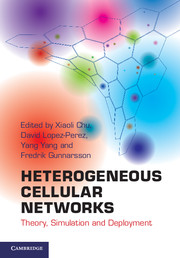Book contents
- Frontmatter
- Contents
- Acknowledgments
- Forewords
- Preface
- List of contributors
- Acronyms
- 1 Introduction
- 2 Radio propagation modeling
- 3 System-level simulation and evaluation models
- 4 Access mechanisms
- 5 Interference modeling and spectrum allocation in two-tier networks
- 6 Self-organization
- 7 Dynamic interference management
- 8 Uncoordinated femtocell deployments
- 9 Mobility and handover management
- 10 Cooperative relaying
- 11 Network MIMO techniques
- 12 Network coding
- 13 Cognitive radio
- 14 Energy-efficient architectures and techniques
- Intex
5 - Interference modeling and spectrum allocation in two-tier networks
Published online by Cambridge University Press: 05 June 2013
- Frontmatter
- Contents
- Acknowledgments
- Forewords
- Preface
- List of contributors
- Acronyms
- 1 Introduction
- 2 Radio propagation modeling
- 3 System-level simulation and evaluation models
- 4 Access mechanisms
- 5 Interference modeling and spectrum allocation in two-tier networks
- 6 Self-organization
- 7 Dynamic interference management
- 8 Uncoordinated femtocell deployments
- 9 Mobility and handover management
- 10 Cooperative relaying
- 11 Network MIMO techniques
- 12 Network coding
- 13 Cognitive radio
- 14 Energy-efficient architectures and techniques
- Intex
Summary
Introduction
Cellular networks have been undebatably a success story, which resulted in wide proliferation and demand for ubiquitous heterogeneous broadband mobile wireless services. With the exponential increase in high-rate traffic driven by a new generation of wireless devices, data is expected to overwhelm cellular network capacity in the near future. Multi-tier heterogeneous cellular networks (HCNs) have been recently proposed as an efficient and cost-effective approach to provide unprecedented levels of network capacity and coverage. Cellular operators have started integrating small cells as a means to provide dedicated additional capacity either where most data usage generally occurs (i.e., enterprises, households) or where user equipments (UEs) are likely to experience poor data rate performance (i.e., cell edges, subway stations and households). Small cells such as femtocells offer radio coverage through a given wireless technology while a broadband wired link connects them to the backhaul network of a cellular operator. In conventional single-tier networks, the macrocell base stations (MBSs) have to cater to the needs of both outdoor and indoor UEs, which leads to poor indoor coverage and the appearance of dead spots [1–3]. In contrast, in femtocell-aided cellular networks, indoor UEs can enjoy high-quality wireless service from their designated femtocell access points (FAPs) in close proximity and outdoor UEs can experience higher capacity gains due to traffic offload by FAPs through the backhaul. Moreover, FAPs have the economical advantage of being less costly to manufacture and maintain as compared with MBSs.
- Type
- Chapter
- Information
- Heterogeneous Cellular NetworksTheory, Simulation and Deployment, pp. 111 - 144Publisher: Cambridge University PressPrint publication year: 2013



